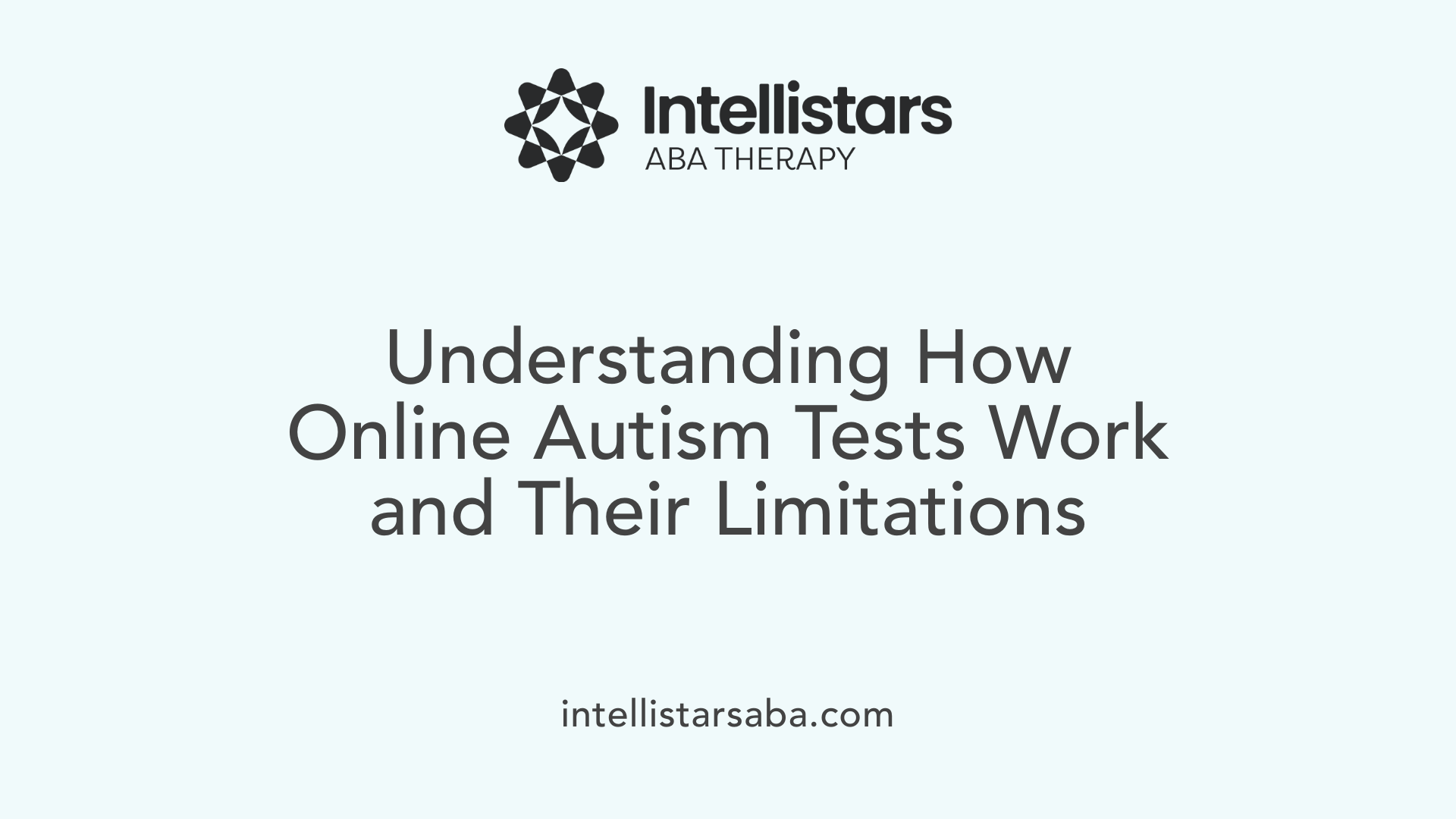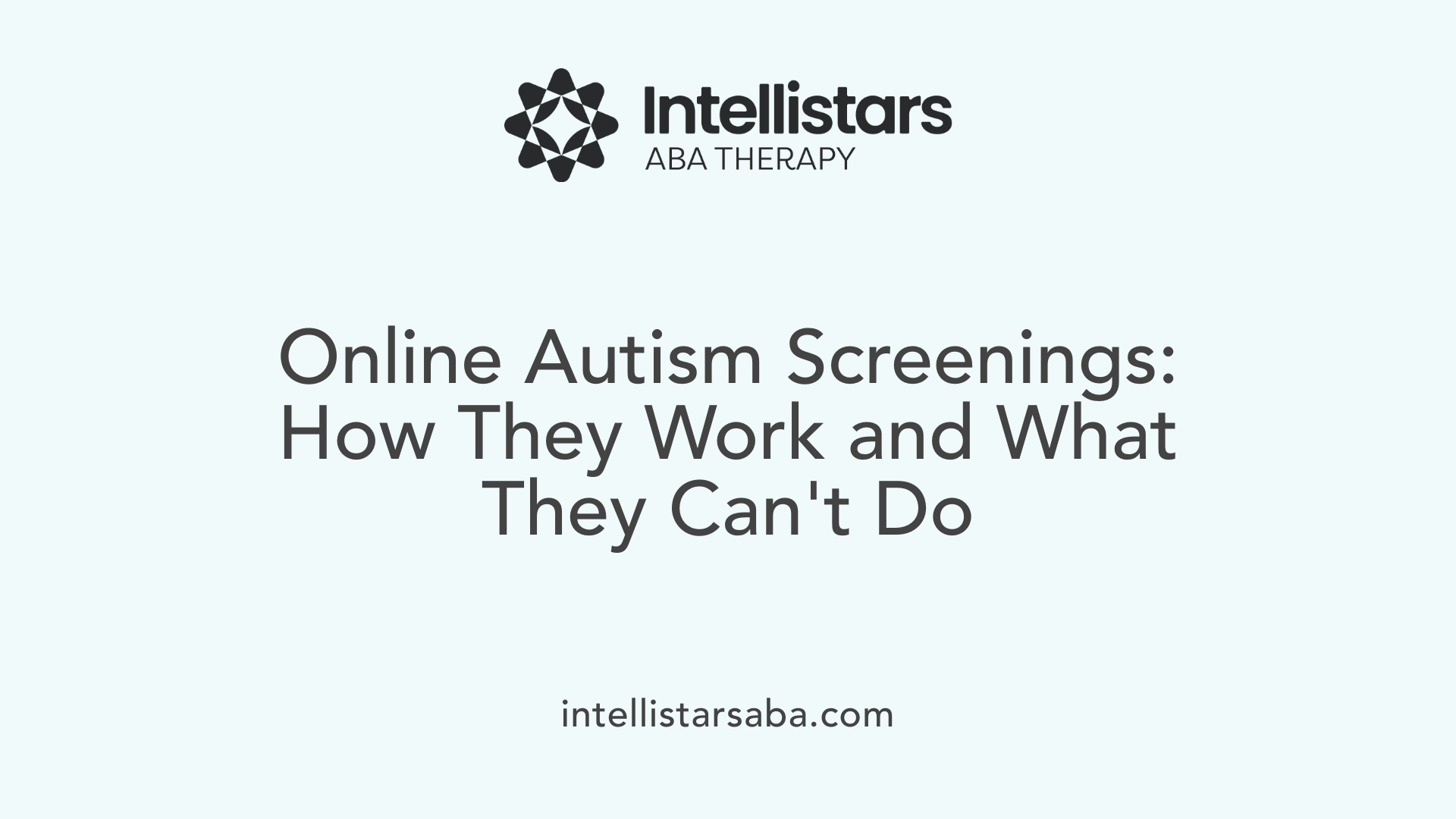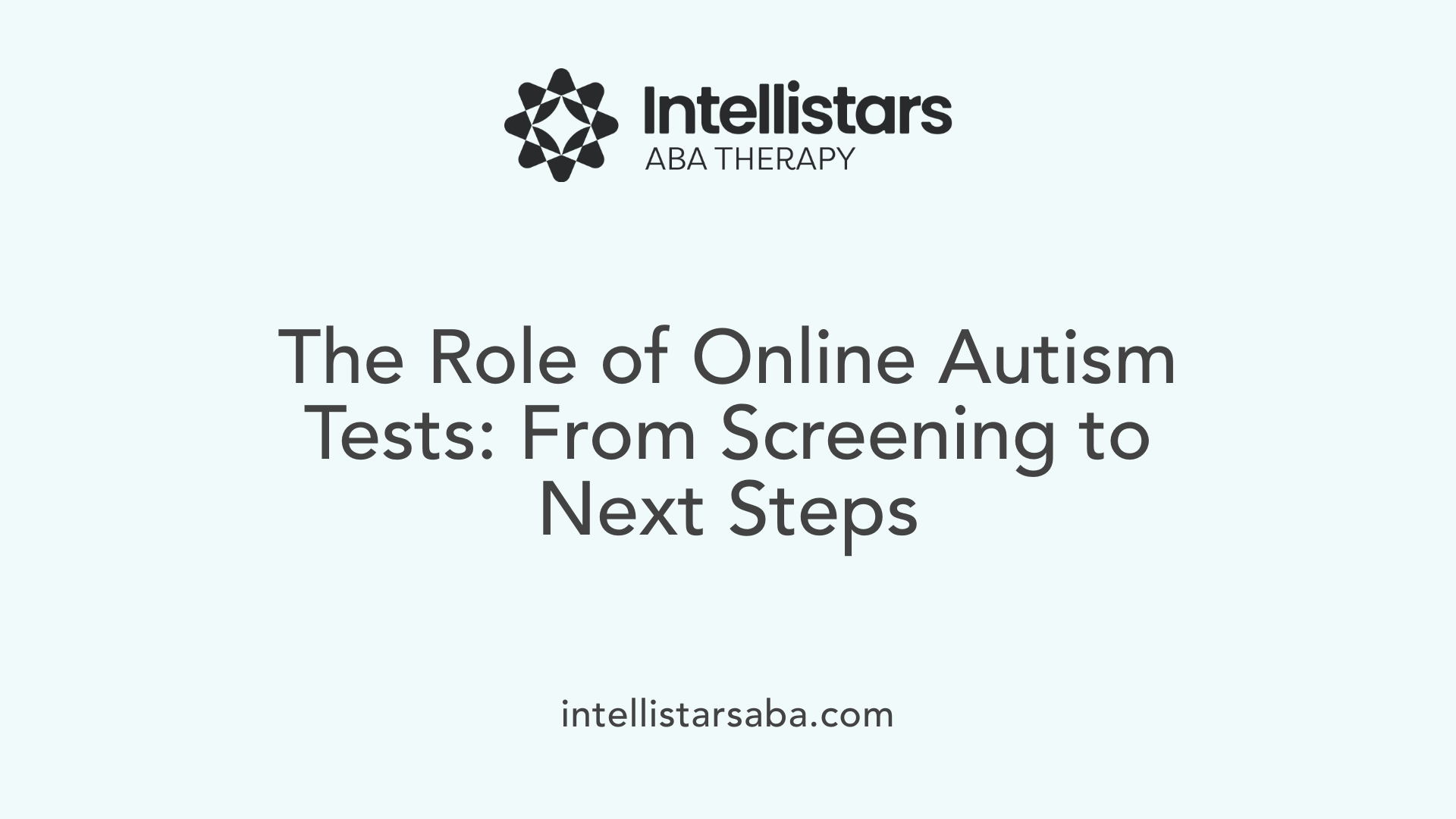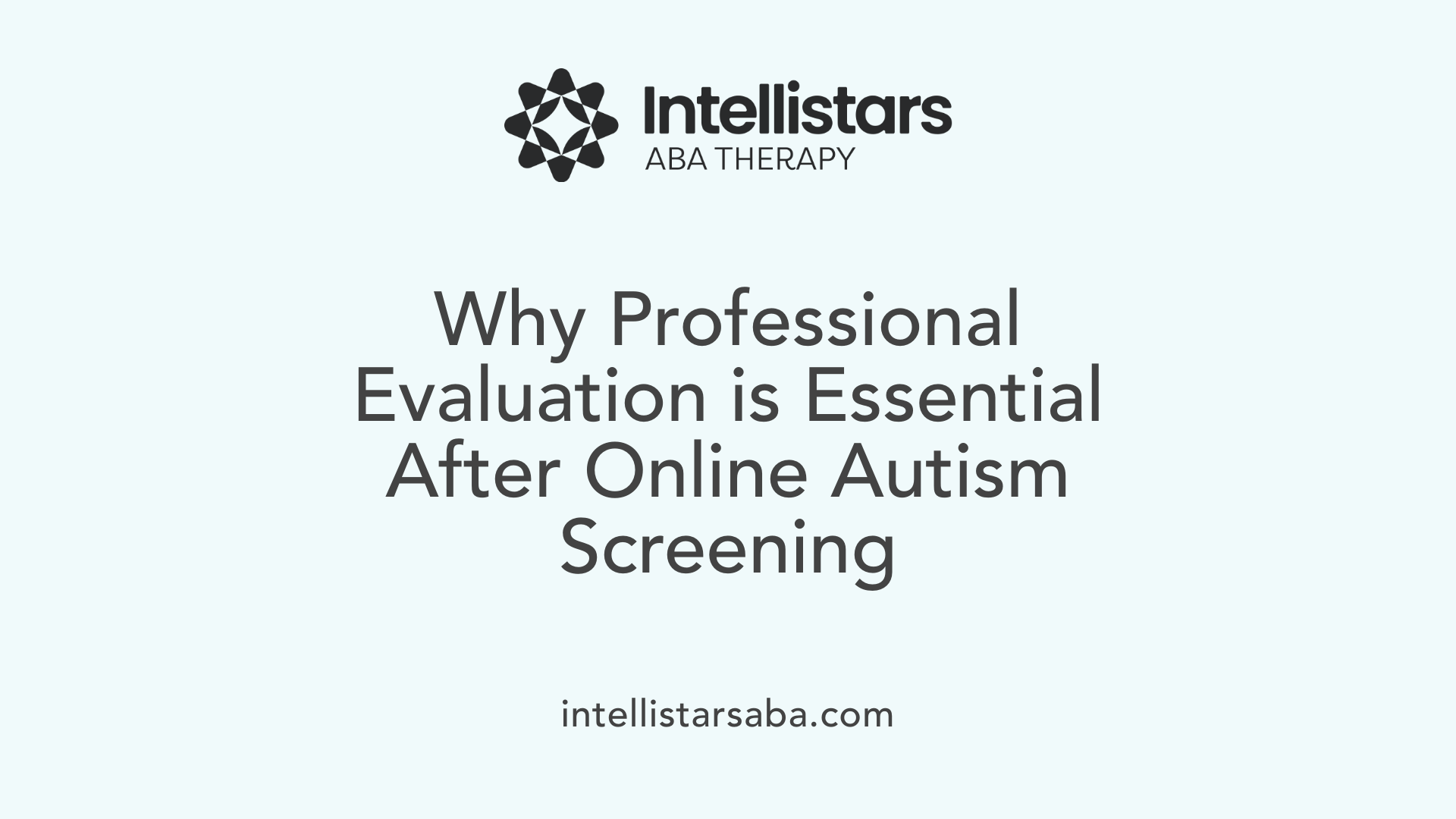Understanding the Role and Reliability of Digital Screening Tools in Autism Detection
With increasing accessibility to online resources, many individuals turn to digital autism tests for initial insights into their behaviors and characteristics associated with autism spectrum disorder (ASD). While these tools offer convenience and preliminary guidance, their accuracy and reliability are often questioned. This article explores how online autism tests work, their limitations, and the critical importance of professional evaluation in diagnosing autism.
The Function and Reliability of Online Autism Tests

How do online autism tests work?
Online autism tests are self-administered questionnaires that aim to identify traits commonly associated with autism spectrum disorders. These assessments, such as the Autism Quotient (AQ), Empathy Quotient (EQ), and others like RAADS and the Aspie Quiz, are designed to evaluate preferences and behaviors related to social interaction, communication, repetitive behaviors, and attention to detail. They are accessible via websites and are often based on established instruments used in clinical or research settings.
Typically, these tests ask individuals to answer straightforward questions about their social behaviors, interests, and perceptual tendencies. For example, the AQ measures traits like social skills, communication, imagination, attention to detail, and comfort with change.
While some online tools incorporate validated questions from well-regarded assessments, they do not include the full range of clinical evaluation elements, such as observations, interviews, or medical history. As a result, they provide a preliminary indication rather than a comprehensive diagnosis.
Research validation of tools like AQ
The Autism Quotient (AQ) was developed by researchers at the Cambridge Autism Research Centre in 2001. It has been extensively validated through multiple studies, both in clinical and research contexts. Its primary purpose is to provide a standardized measure of autistic traits, useful in screening and research to assess where an individual might fall on the autism spectrum.
The AQ's reliability has been confirmed by ongoing research, making it a trusted tool for initial screening. However, even validated tools cannot substitute for detailed clinical evaluations when diagnosing autism.
Limitations in sensitivity and specificity
Despite their usefulness, online tests like the AQ and others have significant limitations. They are designed to indicate whether someone exhibits traits associated with autism, but they are not sensitive or specific enough to confirm a diagnosis.
For example, the M-CHAT-R/F, a screening test for children, has a predictive value of about 57.7%. This means that nearly half of the children who screen positive may not have autism after further assessment, while some with negative screens could still be diagnosed later.
The tools often lack the ability to detect external risk factors such as prematurity or family history, which are important in a full diagnostic process.
Screening versus diagnostic accuracy
It is essential to distinguish between screening and diagnosing. Online tests are valuable screening tools—they can raise awareness and suggest whether further professional evaluation is necessary. However, they do not provide a definitive diagnosis.
A complete diagnosis involves thorough evaluations by healthcare professionals, including observations, interviews, standardized assessments like ADOS or ADI-R, and consideration of developmental history and environmental factors.
In summary, while online assessments can be informative and help guide individuals towards seeking professional advice, they should never be relied upon solely for diagnosis. The role of these screens is to identify who may benefit from detailed clinical assessment, not to replace it.
Understanding How Online Autism Screenings Function and Their Boundaries

How do online autism tests work, and what are their limitations?
Online autism assessments typically involve self-report questionnaires or screening tools designed to identify behaviors associated with autism spectrum disorder (ASD). Examples include the Autism Quotient (AQ), RAADS, and the M-CHAT-R/F, among others. These tools ask individuals about their social interactions, communication patterns, repetitive behaviors, and other traits linked to autism.
While these questionnaires can provide helpful insights and guide individuals toward seeking further evaluation, they are not diagnostic instruments. Their primary purpose is to serve as preliminary screening tools that suggest whether someone might benefit from a professional assessment.
However, online tests have several limitations. For instance, they tend to have only moderate predictive value. The M-CHAT-R/F, a popular screening tool for young children, has a predictive accuracy of about 57.7%, meaning that nearly half of the positive results might not lead to an autism diagnosis upon further assessment. The predictive value is higher among children with a higher likelihood of autism, such as those with siblings on the spectrum, but it still cannot confirm a diagnosis.
Biases can also impact results. Factors such as the individual's understanding of the questions, their current emotional state, or anxiety about the process can influence responses. Additionally, online assessments lack the nuanced observations a trained clinician can obtain through in-person evaluations.
For adults, virtual assessments may include interviews, standardized questionnaires like the EQ or SQ, and observation via video calls. These methods are more effective when conducted by clinicians skilled in autism diagnostics, yet they still fall short of the comprehensive evaluations performed face-to-face.
Importantly, no online screening or assessment tool can replace detailed clinical evaluation, which includes thorough developmental history, behavior observation, and standardized diagnostic procedures such as the ADOS or ADI-R. These in-person assessments are essential for an accurate diagnosis.
In summary, online autism tests can be valuable for self-discovery and initial screening but are inherently limited. They should serve as a starting point, prompting individuals to consult healthcare professionals for a comprehensive assessment and confirmation.
Screening Tools vs. Formal Diagnosis: What Sets Them Apart
What is the difference between screening tools and professional diagnosis for autism?
Screening tools are simple questionnaires or checklists designed to flag potential signs of autism spectrum disorder (ASD). Examples like the M-CHAT-R/F are widely used screening questionnaires that ask parents or caregivers about specific behaviors and development milestones. These tools are quick to administer, often online or in clinical settings, and serve to identify children who might need further assessment.
However, these screening tools are not definitive. Their primary purpose is to indicate whether there is a possibility of ASD, prompting a more thorough evaluation. They have limitations, such as false positives or negatives, and do not consider environmental factors or the full developmental context.
In contrast, a formal diagnosis involves a detailed, multi-step process conducted by qualified healthcare professionals. This process includes collecting a comprehensive developmental history, observing behaviors directly, and applying specialized diagnostic tools like the Autism Diagnostic Observation Schedule (ADOS) or the Childhood Autism Rating Scale (CARS). These assessments evaluate social communication, repetitive behaviors, and other core traits of autism.
The diagnostic procedure is also informed by established criteria such as those in the DSM-5 and involves collaboration among psychologists, pediatricians, speech therapists, and other specialists. This rigorous approach ensures that diagnoses are accurate and reliable.
Ultimately, while screening tools can guide whether further testing is necessary, they cannot confirm autism. Only a comprehensive clinical assessment by multidisciplinary teams can establish a definitive diagnosis.
Below is a comparison table summarizing the differences:
| Aspect | Screening Tools | Professional Diagnosis |
|---|---|---|
| Purpose | Initial risk assessment | Confirmatory, detailed evaluation |
| Administered by | Usually trained healthcare professionals or online | Qualified clinicians, including psychologists and pediatricians |
| Time Investment | Usually quick, 5–15 minutes | Multiple sessions, hours of testing |
| Methods | Questionnaires, checklists | Behavioral observation, developmental history, standardized assessments |
| Diagnostic Accuracy | Not definitive | Highly accurate, based on DSM-5 criteria |
| Follow-up Required | Yes, for formal diagnosis | Yes, if screening indicates risk |
Recognizing the difference ensures that families and individuals understand that screening is only a first step. The gold standard remains a comprehensive assessment by trained specialists, which provides the necessary accuracy for diagnosis and support planning.
The Trustworthiness of Self-Administered Online Autism Assessments
Initial screening versus diagnosis
Online autism tests, such as the Autism Quotient (AQ) or the M-CHAT-R/F, are designed primarily as screening tools rather than definitive diagnostic instruments. These assessments can help individuals identify traits associated with autism spectrum disorders (ASD) and determine whether they should seek further professional evaluation. While they can provide initial insights into social communication, empathy, and repetitive behaviors, they do not replace comprehensive clinical assessments.
In clinical settings, diagnosis involves thorough evaluations, including standardized tools like ADOS or ADI-R, conducted by trained professionals. These in-depth examinations consider multiple factors such as development history, observation, and interaction, which online tools cannot fully replicate.
Research on self-identification accuracy
Studies show that online self-assessments can have a reasonable level of accuracy, especially in recognizing traits familiar to the individual. For example, research related to the AQ has demonstrated that self-reported behaviors often correspond with clinical observations.
Research indicates that adults, particularly those with longstanding suspicions of being on the spectrum, can successfully use these online tools to gain awareness about their traits. In some cases, this awareness prompts individuals to seek formal diagnosis and support.
However, the predictive value varies depending on the tool and population studied. For instance, the M-CHAT-R/F has a predictive value of about 57.7% overall, meaning it's a helpful screening step but not a definitive test.
Limitations of self-report
Despite their usefulness, online assessments have notable limitations. Self-report biases, such as under- or over-reporting behaviors or traits, can affect accuracy. Participants might interpret questions differently or be influenced by their current emotional state.
Furthermore, online tools cannot incorporate contextual or environmental information, which is crucial in diagnosing autism. External factors like familial history, developmental delays, or co-occurring conditions often require detailed clinical interviews.
Most experts caution that self-administered online tests should only serve as preliminary indicators. They are helpful for raising awareness but should not be used as final diagnostic tools. Confirming an autism diagnosis necessitates professional evaluation, which ensures all relevant factors are considered.
| Aspect | Description | Limitations |
|---|---|---|
| Screening purpose | Initial identification of traits | Not definitive indications of autism |
| Accuracy | Often aligns with clinical assessments | Subject to bias and misinterpretation |
| Recommended use | Guide for seeking further assessment | Not a substitute for professional diagnosis |
While online autism assessments provide valuable starting points for understanding oneself, they are best used as part of a broader diagnostic pathway. Consulting qualified healthcare providers remains essential for an accurate and comprehensive diagnosis.
Role of Online Tests in the Autism Diagnostic Journey

What is the role of online autism tests in the diagnostic process?
Online autism tests mainly function as first-step screening tools that can help individuals recognize traits associated with autism spectrum disorder (ASD). These tests are designed to highlight potential signs of autism, prompting individuals or parents to seek further evaluation from healthcare experts.
These assessments are not intended for the actual diagnosis. Instead, they provide a general indication of traits related to social interaction, communication, repetitive behaviors, and other features of autism.
For example, online tests like the Autism Quotient (AQ), Empathy Quotient (EQ), or RAADS can help users understand their own behaviors or traits. They are useful for raising awareness and encouraging individuals to consider consulting a professional. Pediatric screening tools like M-CHAT-R/F are similarly used in early detection efforts.
A formal diagnosis involves comprehensive evaluations that include clinical interviews, observations, and standardized tools such as ADOS or ADI-R. Only qualified professionals, including psychologists and developmental pediatricians, can provide this diagnosis based on criteria outlined in the DSM-5.
In summary, online autism tests are valuable for initial awareness and guiding individuals toward the next step—professional assessment. They help identify those who might benefit from detailed evaluation but are not a substitute for clinical diagnosis.
The Importance of Professional Evaluation After Online Screening

Why is a professional evaluation important after taking an online autism test?
While online autism tests can offer initial insights and help individuals understand their traits, they are not designed to provide a definitive diagnosis. These screening tools are useful for raising awareness or guiding further actions but lack the depth and accuracy required for diagnosis.
A thorough, face-to-face assessment conducted by healthcare professionals is critical. Experts can interpret screening results within the wider context of an individual’s developmental history, behavior patterns, and environmental factors. This comprehensive approach helps confirm whether the traits indicated by online tests are part of autism or relate to other conditions.
Moreover, professionals are trained to distinguish autism from other conditions with similar symptoms, such as anxiety or social challenges. This prevents misdiagnosis and ensures the person receives appropriate support.
Online questionnaires, such as the Autism Quotient (AQ) or M-CHAT-R/F, are useful tools but have limitations. For example, the M-CHAT-R/F has a predictive accuracy of about 57.7%, meaning it can suggest a likelihood but cannot confirm autism alone. Its results should always be followed by a detailed clinical evaluation.
In addition, a formal assessment involves multiple observations, standard tests like the ADOS or ADI-R, and discussions that consider physical, psychological, and social factors. These assessments provide a more precise understanding of an individual’s needs.
Ultimately, professional judgment and comprehensive diagnosis ensure accurate identification of autism, enabling tailored interventions and support plans that online tests cannot reliably offer.
The Path to Accurate Autism Diagnosis
While online autism tests can serve as valuable initial indicators and aid in self-awareness, they are not substitutes for thorough, professional assessments. Recognizing their limitations is crucial for making informed decisions about further evaluation and support. Ultimately, a conclusive diagnosis requires a comprehensive clinical examination by trained healthcare providers, utilizing standardized diagnostic tools and considering all developmental factors. If online tests suggest possible traits of autism, it is important to consult qualified professionals who can carry out detailed assessments and provide the necessary guidance for appropriate intervention. This layered approach ensures that individuals receive accurate diagnoses and the support they need to thrive.
References
- Best Online Autism Tests
- Autism Test | Am I Autistic Quiz | Free & Online
- Autism Spectrum Quotient (AQ) - Psychology Tools
- The limitations of online tests and online assessments for autism
- How Accurate are Online Autism Tests? - Today's Parent
- New study finds common autism screening tool is effective but has ...
- The limitations of online tests and online assessments for autism
- Autism Spectrum Quotient
- New study finds common autism screening tool is effective but has ...






